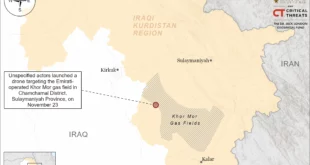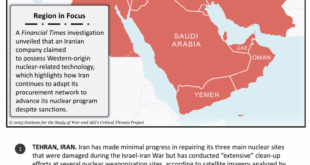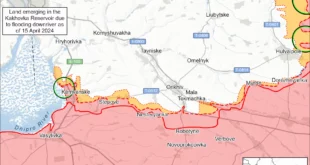A recent border clash between Iranian and Taliban forces marked the latest phase of a longstanding water rights dispute between the two countries.
The fighting might upend Tehran’s relationship with Taliban leaders, which is already burdened by the Taliban’s brutal treatment of Shia Muslims and some Persian-speaking Afghan groups.
Both governments are adversaries of the United States and its allies, but U.S. officials engage Taliban leaders on a range of issues and support their efforts to combat more radical Islamist terrorist groups.
During the clashes, the Taliban used U.S.-made military equipment left behind when American forces and allies withdrew from the country in August 2021.
On May 27, clashes broke out between Taliban and Iranian forces on their joint border along Afghanistan’s Nimroz province, escalating a dispute between Iran and the Taliban movement over access to water resources. Two Iranian border guards and one Taliban fighter were killed in the initial confrontation, although there were unconfirmed reports of additional Taliban and civilian casualties. Iranian and Taliban security forces both accused the other of firing the first shot. The conflict posed an immediate threat to Iran’s engagement of Taliban leaders, which was jeopardized by Iranian concerns about Taliban’s treatment of the non-Pashtun minorities, over whom Iran wields political influence and with whom it has strong religious and cultural ties. These groups include the long-persecuted Shia Muslim Hazara community and Afghan Tajiks. Iran and the Taliban nearly went to war in 1998 when the first Taliban regime killed at least eight Iranian diplomats at Iran’s consulate in Mazar-e-Sharif – an episode that stemmed from Iran’s objections to the Taliban’s treatment of the Hazara.
The recent clashes have contributed to growing tensions between the two countries over the sharing of water from the Helmand River, one of two rivers that flow from Afghanistan into Iran. According to the bilateral Afghan Iranian Water Treaty of 1973, Afghanistan is expected to provide 850 million cubic meters water to Iran every year from the river. However, due largely to climate change and the country’s inefficient water management system, Afghanistan has been facing drought-like situations in recent years and has not met its obligation to Iran. Facing its own water challenges, Iran has been pressing for its agreed share of water from that source.
Drought has been a problem in Iran for some 30 years, but has worsened over the past decade. According to a joint report by the Iranian Space Agency and UN-SPIDER, the UN’s space-based disaster management organization, “most rivers in [Iran] are either dry or severely depleted” ever since a particularly harsh three-year drought concluded in 2002. The Iran Meteorological Organization says an estimated 97% of the country now faces some level of drought. In 2021, these conditions led to protests across multiple Iranian cities. This eventually led to a violent government response, as police dispersed demonstrations by burning down tents and firing teargas into crowds. A week before the most recent border skirmish, Iranian President Ebrahim Raisi warned the Taliban to respect Iran’s rights to water under the 1973 treaty. Iran has previously accused Afghanistan of withholding water as a punishment for Iran’s treatment of Afghan refugees in the country. A statement shared by Taliban spokesperson Zabihullah Mujahid on Twitter said that Raisi’s “frequent demands for water” were “harmful” in light of Afghanistan’s own drought situation and warned that Iranian statements on the matter had put the countries’ bilateral relations at risk.
The fighting has threatened Iranian diplomacy with its neighbor. Since the Taliban’s return to power in 2021, Iran has hosted meetings with Taliban figures, and although Iran still does not formally recognize the Taliban’s governing authority, it allowed the Taliban to operate the Afghan Embassy in Tehran as of February 2023. Some Iranian officials sought to limit the diplomatic fallout of the clashes by attributing threatening Taliban statements against Iran to “low-ranking” members of the Taliban who have since been “dismissed” by the organization. Meanwhile, the deputy spokesman of the Taliban’s Ministry of Foreign Affairs told a Saudi newspaper that the group sought to preserve relations with its neighbors and did not want to see the situation to escalate.
The global community, and particularly the United States, has been hesitant to take any position on a dispute between two regimes, and no country has yet recognized the Taliban as the legitimate government of Afghanistan. U.S officials remain suspicious of the Taliban’s commitment to deny safe haven to al-Qaeda figures, particularly since the killing of Ayman al Zawahiri by a U.S. airstrike in July 2022 revealed he was residing comfortably in Kabul. They also oppose the group’s treatment of women and minorities, as well as its human rights practices more generally. However, a wide range of diplomats, primarily from the region but also from the United States and its allies, engage Taliban leaders in Afghanistan and in Qatar, where Taliban leaders maintain a significant diplomatic presence. U.S. and other Western leaders are also at odds with the leaders in Tehran over issues including the expansion of its nuclear program, its provision of missiles and armed drones to regional armed factions, and its supply of drones to the Russian war effort in Ukraine. Some U.S. leaders assess that Iran’s clashes with the Taliban can serve to weaken or embarrass Tehran’s forces and distract the Iranian government from its objectives in Syria, Iraq, Yemen, Lebanon, and elsewhere where its own forces or proxy forces are operating.
The border skirmishing also exhibited the lingering consequences of the U.S. withdrawal from Afghanistan, as videos on social media depicted Taliban fighters deploying to the Iran border with U.S-made weaponry, including multiple Humvees (at least one of which appeared armed with an M240 machine gun) in addition to an American military truck transporting a Soviet Howitzer. Following the rapid collapse of the previous Afghan government’s security forces, the Taliban seized control of their weapon stockpiles. Of the $18.6 billion worth of military equipment provided to the Afghan National Security Forces by the United States over 16 years, some 37 percent of that – approximately $7 billion worth – was left behind, according to the U.S. Department of Defense.
 Eurasia Press & News
Eurasia Press & News



